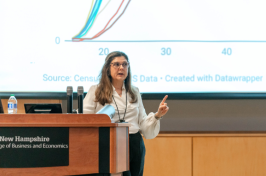Rural Students Face Additional Challenges Due To Lack of Funding and Resources
American students living in the suburbs are outpacing their urban and rural counterparts in mathematics achievement, with Asian and white students scoring the highest among all races and ethnicities, and students from higher socioeconomic backgrounds doing better overall, according to new research from the Carsey Institute at the University of New Hampshire.
The research was conducted by Suzanne Graham, associate professor of education at UNH and faculty fellow at the Carsey Institute, and Lauren Provost, doctoral candidate in education at UNH. It is presented in the brief “Mathematics Achievement Gaps Between Suburban Students and their Rural and Urban Peers Increase Over Time.”
“Developing strong mathematical skills early in life is necessary for all students. At the most basic level, an understanding of mathematics is necessary for citizens to evaluate major financial decisions such as whether to buy a house or take a job, plan a family budget, and understand political polls. Mathematics also helps students develop general problem-solving skills. Furthermore, without a strong foundation in early mathematics, students are not prepared to enroll in more advanced mathematics courses at the high school and college level,” Graham said.
The key research findings are as follows:
- Rural and urban kindergarten students have slightly lower average mathematics achievement levels than their suburban peers.
- The average increase in mathematics achievement from kindergarten to eighth grade for rural and urban children is smaller than the increase for suburban children, resulting in a widening achievement gap over time.
- Average differences in mathematics achievement favoring suburban children exist in the Northeast, South, and Midwest, but not in the West.
- Average achievement differences between rural, urban, and suburban students are larger for Asian and Native American students than for white, African-American, and Hispanic students.
- Family socioeconomic status explains much, but not all, of the observed differences in average mathematics achievement levels of rural, urban, and suburban children.
This analysis is based on data from the Early Childhood Longitudinal Study, a multiyear study of a nationally representative sample of more than 22,000 children between 1998 and 2006.
The Carsey Institute conducts policy research on vulnerable children, youth, and families and on sustainable community development. The institute gives policy makers and practitioners the timely, independent resources they need to effect change in their communities. For more information about the Carsey Institute, go to www.carseyinstitute.unh.edu.
Originally published by:
UNH Media Relations
Written by Lori Wright, UNH Media Relations














































